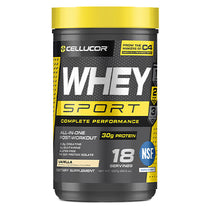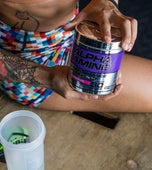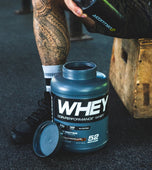
Signs You Need a Rest Day
Wondering if you need a rest day?
Do your knees buckle a little when it comes time to squat a weight you normally do for reps? Maybe your mile time has been taking a dip even though you’ve been training consistently. Or maybe you’re feeling more winded between sets while doing your normal workouts.
For some people the signs may be noticeable outside of the gym, like an elevated resting heart rate, taking longer to recover from workouts, or constantly feeling tired. Whatever the case, our bodies will often give us signs when our nutrition and recovery aren’t up to par with the demands, we’re placing on them.
Some of the most reported signs of overtraining in the scientific literature include poor athletic performance, constant fatigue, muscle soreness, overuse injuries, reduced appetite, impaired sleep patterns and mood, immune system deficits, and difficulty concentrating.[1]

Benefits of Rest & Active Recovery Period
Planning full rest days or active recovery days can allow your body to have more time for recovery from intense workouts. It may also help reduce injury, delayed onset muscle soreness (DOMS), and muscle fatigue. Finally, to promote muscle growth you want to give your body some time to repair and recover from lifting by being in a state of positive protein balance.

Rest Days Per Week, By Goal
The number of rest days you need will vary based on the intensity, frequency of your workouts, and the number of stressors you have outside of the gym (professional and personal).
This is why it’s important to listen to your body, keep track of your strength training & performance, and how recovered you feel when deciding on how many rest days per week you need. As a general guide, these are the typical rest days that these groups take:
Rest Days for Beginners
Beginners will often take a greater amount of rest days because they tend to experience greater amounts of delayed onset muscle soreness (DOMS) after an exercise routine. As their bodies adapt to increased training intensities and volume, they’re able to train more days per week. For beginners, the American College of Sports Medicine recommends 2-3 training days per week.[2] This would leave beginners following this training frequency with 4-5 rest days per week.
Rest Days for Runners / Cycling/ Triathlons
For cardiovascular-intensive sports, it can be common to log a significant number of miles per week in one’s program, especially if this training is done in preparation for a competition. Because these types of workouts can be high volume, athletes in these sports are vulnerable to overuse injuries. The USA Triathlon team recommends at least one full rest day per week.[3]
Rest Days for Bodybuilding
Bodybuilders seek to maximize muscle growth in their training programs, as a result, they seek to strike a balance between high-volume training and sufficient rest. For the purposes of muscle growth, research shows that 12-28 sets per muscle group per week are beneficial.[4] Advanced bodybuilders and weightlifters generally train 4-6 days per week, with 1-3 rest days per week.[5]
Rest Days for Weight Loss
Individuals looking to lose weight are focused on increasing their daily caloric expenditure to be in a consistent caloric deficit. These individuals generally only rest for 1-2 days per week. They also often use these rest days as active recovery days so that this movement can contribute to their daily caloric expenditure.

What an Active Recovery Day Looks Like
Active recovery involves low-intensity, low-impact exercise. Active recovery workouts are a popular strategy to use on rest days to increase blood flow to sore muscles and increase daily caloric expenditure. Some popular forms of an active rest day include
Cardio: Cardio workouts like jogging, cycling, or swimming are popular forms of active recovery exercise. Cardiovascular exercise supports increased aerobic fitness (VO2 Max, cardiac output, recovery between sets), increased blood flow to sore muscles for improved nutrient delivery, and waste product removal.An active recovery jog workout would look like this
- Jog for 30 minutes at a comfortable pace (intensity should feel like a 6/10)
- Incorporate walking and stretching breaks as needed to prevent fatigue.
An active recovery yoga routine you could try would look like this:
- Cat-Cow Stretch: Start on your hands and knees, then alternate between arching your back and rounding it, moving slowly and smoothly. Repeat for 30 seconds to 1 minute.
- Downward-Facing Dog: Begin on your hands and knees, then lift your hips up and back, straightening your arms and legs. Hold for 30 seconds to 1 minute.
- Pigeon Pose: Start in a downward-facing dog position, then bring one knee forward and turn it out to the side, lowering your hip to the ground. Hold for 30 seconds to 1 minute on each side.
- Seated Forward Bend: Sit on the ground with your legs straight out in front of you, then reach forward to touch your toes. Hold for 30 seconds to 1 minute.
- Warrior II: Stand with your feet hip-width apart, then step one foot back and turn it out to the side, lowering into a lunge. Raise your arms to shoulder height and hold for 30 seconds to 1 minute on each side.
- Corpse Pose: Lie on your back, arms and legs extended, and relax your entire body. Hold for 5 minutes or more.
An active recovery kettlebell workout you can try would look like this
EMOM for 20 minutes:
- Minute 1: 10 goblet squats with a light kettlebell
- Minute 2: 10 Russian kettlebell swings with a light kettlebell
- Minute 3: 10 single-arm kettlebell presses with a light kettlebell (5 reps per arm)
- Minute 4: Rest

Supplements that Support Hydration & Recovery
XTEND Original: Formulated to support muscle recovery and hydration, XTEND Original provides 7G of BCAAs and hydrating electrolytes, all while delivering mouthwatering flavors with zero sugar - it's no wonder that XTEND Original has been the go-to recovery choice for over a decade.
XTEND Pro: Featuring 25g of Whey Isolate and 7g total BCAAs per serving, XTEND Pro takes muscle repair and recovery to the next level. With delicious gluten-free flavors and two third-party certifications, it's no wonder that XTEND Pro is the protein choice of champions!
Alpha Amino: The ultimate performance, hydration, and recovery sports drink powder. Whether you’re just starting out, or ready to reach that next level, Alpha Amino will support you throughout your entire journey. Be ready and recovered for whatever tomorrow brings.
References
[1] https://link.springer.com/article/10.2165/00007256-199826010-00001
[2] https://pubmed.ncbi.nlm.nih.gov/19204579/





















